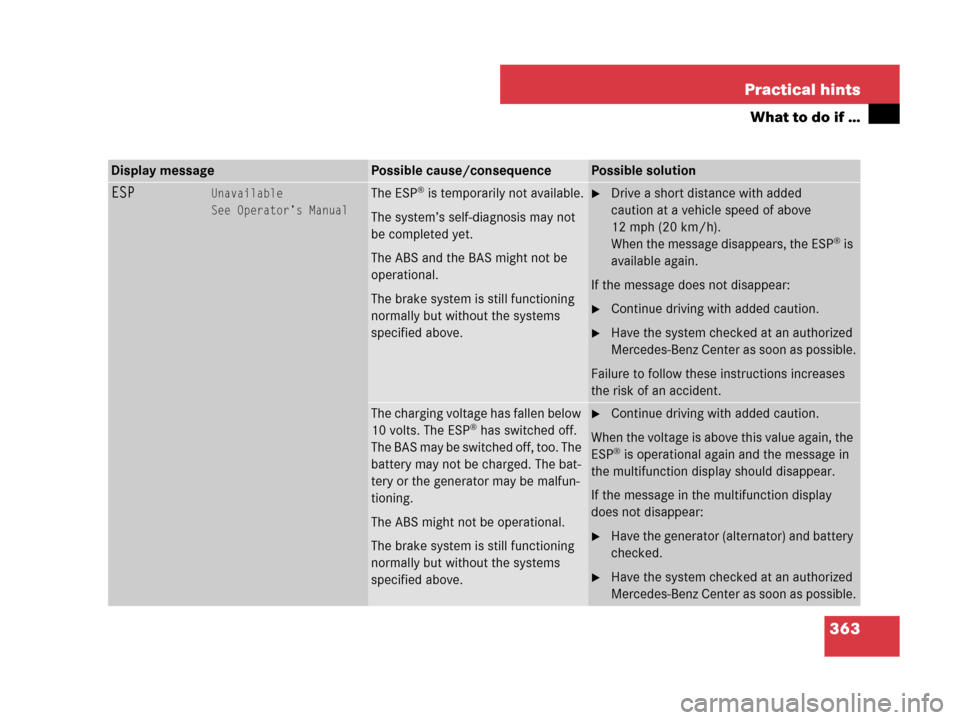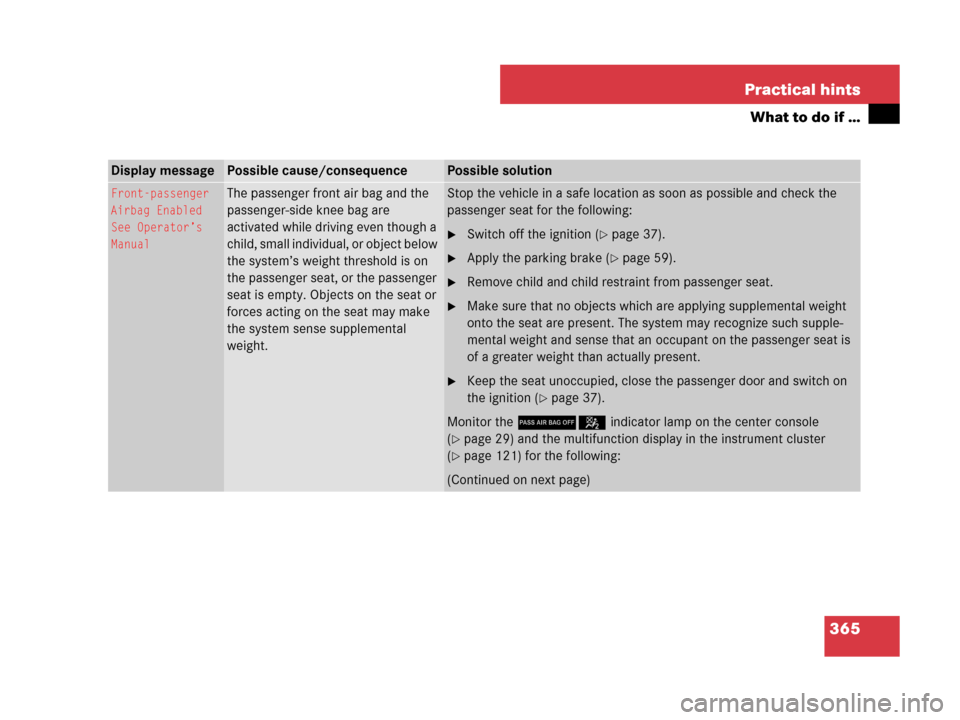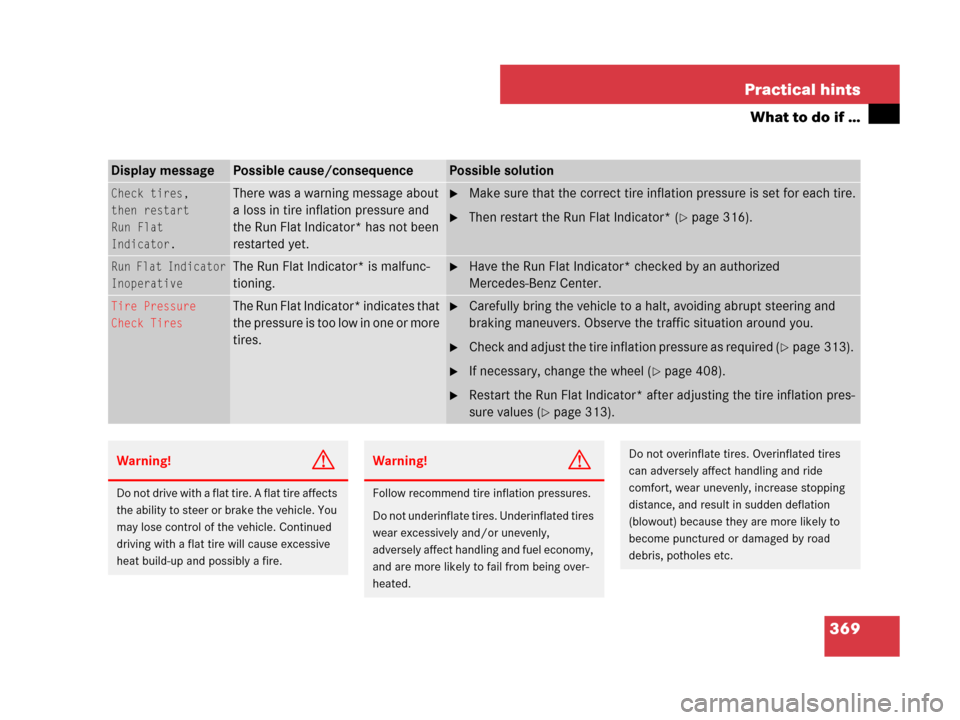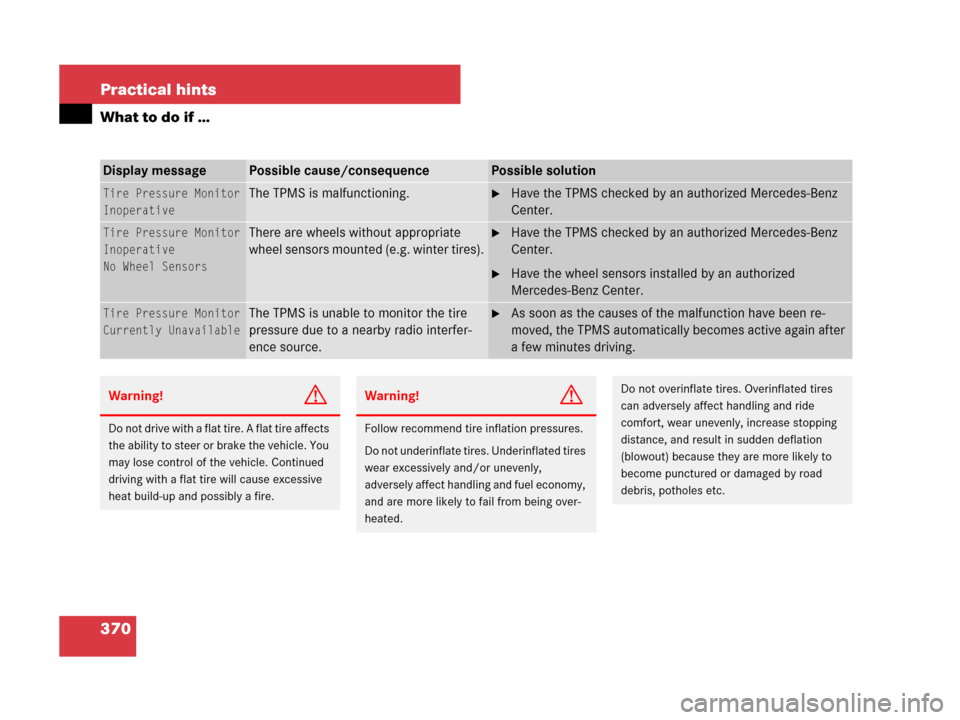Page 363 of 474

362 Practical hints
What to do if …
Text messages
Display messagePossible cause/consequencePossible solution
ABSABS, ESP Inoperative
See Operators’s ManualThe ABS and ESP® are not available
due to a malfunction.
The BAS is also deactivated.
The brake system is still functioning
normally but without the systems
specified above.�Continue driving with added caution. Wheels
may lock during hard braking, reducing
steering capability.
�Have the system checked at an authorized
Mercedes-Benz Center as soon as possible.
Failure to follow these instructions increases
the risk of an accident.
Cruise
ControlInoperativeThe cruise control is malfunction-
ing.�Have the cruise control checked by an
authorized Mercedes-Benz Center.
ESPInoperative
See Operator’s ManualThe ESP® has switched off due to a
malfunction.
The ABS and the BAS might not be
operational.
The brake system is still functioning
normally but without the systems
specified above.�Continue driving with added caution.
�Have the system checked at an authorized
Mercedes-Benz Center as soon as possible.
Failure to follow these instructions increases
the risk of an accident.
Page 364 of 474

363 Practical hints
What to do if …
Display messagePossible cause/consequencePossible solution
ESPUnavailable
See Operator’s ManualThe ESP® is temporarily not available.
The system’s self-diagnosis may not
be completed yet.
The ABS and the BAS might not be
operational.
The brake system is still functioning
normally but without the systems
specified above.�Drive a short distance with added
caution at a vehicle speed of above
12 mph (20 km/h).
When the message disappears, the ESP
® is
available again.
If the message does not disappear:
�Continue driving with added caution.
�Have the system checked at an authorized
Mercedes-Benz Center as soon as possible.
Failure to follow these instructions increases
the risk of an accident.
The charging voltage has fallen below
10 volts. The ESP® has switched off.
The BAS may be switched off, too. The
battery may not be charged. The bat-
tery or the generator may be malfun-
tioning.
The ABS might not be operational.
The brake system is still functioning
normally but without the systems
specified above.
�Continue driving with added caution.
When the voltage is above this value again, the
ESP
® is operational again and the message in
the multifunction display should disappear.
If the message in the multifunction display
does not disappear:
�Have the generator (alternator) and battery
checked.
�Have the system checked at an authorized
Mercedes-Benz Center as soon as possible.
Page 366 of 474

365 Practical hints
What to do if …
Display message Possible cause/consequencePossible solution
Front-passenger
Airbag Enabled
See Operator’s
ManualThe passenger front air bag and the
passenger-side knee bag are
activated while driving even though a
child, small individual, or object below
the system’s weight threshold is on
the passenger seat, or the passenger
seat is empty. Objects on the seat or
forces acting on the seat may make
the system sense supplemental
weight.Stop the vehicle in a safe location as soon as possible and check the
passenger seat for the following:
�Switch off the ignition (�page 37).
�Apply the parking brake (�page 59).
�Remove child and child restraint from passenger seat.
�Make sure that no objects which are applying supplemental weight
onto the seat are present. The system may recognize such supple-
mental weight and sense that an occupant on the passenger seat is
of a greater weight than actually present.
�Keep the seat unoccupied, close the passenger door and switch on
the ignition (
�page 37).
Monitor the 75indicator lamp on the center console
(
�page 29) and the multifunction display in the instrument cluster
(
�page 121) for the following:
(Continued on next page)
Page 368 of 474
367 Practical hints
What to do if …
Display messagePossible cause/consequencePossible solution
Front-passenger
Airbag Disabled
See Operator’s
ManualThe passenger front air bag and the
passenger-side knee bag are
deactivated while driving even though
an adult or someone larger than a
small individual is occupying the front
passenger seat. Forces acting on the
seat may make the system sense a
decrease in weight.Stop the vehicle in a safe location as soon as possible and check the
passenger seat for the following:
�Switch off the ignition (�page 37).
�Apply the parking brake (�page 59).
�Have the passenger vacate the seat and exit the vehicle.
�Keep the seat unoccupied, close the passenger door and switch on
the ignition (
�page 37).
Monitor the 75indicator lamp on the center console
(
�page 29) and the multifunction display in the instrument cluster
(
�page 121) for the following:
(Continued on next page)
Page 370 of 474

369 Practical hints
What to do if …
Display messagePossible cause/consequencePossible solution
Check tires,
then restart
Run Flat
Indicator.There was a warning message about
a loss in tire inflation pressure and
the Run Flat Indicator* has not been
restarted yet.�Make sure that the correct tire inflation pressure is set for each tire.
�Then restart the Run Flat Indicator* (�page 316).
Run Flat Indicator
InoperativeThe Run Flat Indicator* is malfunc-
tioning.�Have the Run Flat Indicator* checked by an authorized
Mercedes-Benz Center.
Tire Pressure
Check TiresThe Run Flat Indicator* indicates that
the pressure is too low in one or more
tires.�Carefully bring the vehicle to a halt, avoiding abrupt steering and
braking maneuvers. Observe the traffic situation around you.
�Check and adjust the tire inflation pressure as required (�page 313).
�If necessary, change the wheel (�page 408).
�Restart the Run Flat Indicator* after adjusting the tire inflation pres-
sure values (
�page 313).
Warning!G
Do not drive with a flat tire. A flat tire affects
the ability to steer or brake the vehicle. You
may lose control of the vehicle. Continued
driving with a flat tire will cause excessive
heat build-up and possibly a fire.
Warning!G
Follow recommend tire inflation pressures.
Do not underinflate tires. Underinflated tires
wear excessively and/or unevenly,
adversely affect handling and fuel economy,
and are more likely to fail from being over-
heated.
Do not overinflate tires. Overinflated tires
can adversely affect handling and ride
comfort, wear unevenly, increase stopping
distance, and result in sudden deflation
(blowout) because they are more likely to
become punctured or damaged by road
debris, potholes etc.
Page 371 of 474

370 Practical hints
What to do if …
Display messagePossible cause/consequencePossible solution
Tire Pressure Monitor
InoperativeThe TPMS is malfunctioning.�Have the TPMS checked by an authorized Mercedes-Benz
Center.
Tire Pressure Monitor
Inoperative
No Wheel SensorsThere are wheels without appropriate
wheel sensors mounted (e.g. winter tires).�Have the TPMS checked by an authorized Mercedes-Benz
Center.
�Have the wheel sensors installed by an authorized
Mercedes-Benz Center.
Tire Pressure Monitor
Currently UnavailableThe TPMS is unable to monitor the tire
pressure due to a nearby radio interfer-
ence source.�As soon as the causes of the malfunction have been re-
moved, the TPMS automatically becomes active again after
a few minutes driving.
Warning!G
Do not drive with a flat tire. A flat tire affects
the ability to steer or brake the vehicle. You
may lose control of the vehicle. Continued
driving with a flat tire will cause excessive
heat build-up and possibly a fire.
Warning!G
Follow recommend tire inflation pressures.
Do not underinflate tires. Underinflated tires
wear excessively and/or unevenly,
adversely affect handling and fuel economy,
and are more likely to fail from being over-
heated.
Do not overinflate tires. Overinflated tires
can adversely affect handling and ride
comfort, wear unevenly, increase stopping
distance, and result in sudden deflation
(blowout) because they are more likely to
become punctured or damaged by road
debris, potholes etc.
Page 372 of 474
371 Practical hints
What to do if …
Symbol messages
Display symbolDisplay messagePossible cause/consequencePossible solution
ÊThis message will appear whenever
the trunk lid is open.�Close the trunk lid.
OYou are driving with the hood open.Risk of accident!
�Stop the vehicle in a safe location or as soon
as it is safe to do so.
�Apply the parking brake (�page 59).
�Close the hood (�page 294).
JYou are driving with one or more
doors open.�Close the doors.
•The cooling fan for the coolant is
malfunctioning.�Observe the coolant temperature display
(
�page 127).
If the coolant temperature is below 120°C,
you may continue driving to the nearest
specialist workshop.
�Avoid heavy loads on the engine (e.g. by
driving uphill) as well as stop-and-go traffic.
�Have the fan replaced as soon as possible.
Page 373 of 474
372 Practical hints
What to do if …
Display symbolDisplay messagePossible cause/consequencePossible solution
#The battery is no longer charging.
Possible causes:
�Alternator malfunctioning
�Broken poly-V-belt
Do not forget that the brake system
requires electrical energy and may
be operating with restricted capa-
bility. Considerably greater brake
pedal force is required and the stop-
ping distance is increased.
�Stop the vehicle immediately in a safe loca-
tion and check the poly-V-belt.
If it is broken:
�Do not continue to drive.
Otherwise, the engine will overheat due
to an inoperative water pump which may
result in damage to the engine. Contact
an authorized Mercedes-Benz Center.
If it is in order:
�Contact an Mercedes-Benz Center
immediately. Adjust driving to be consis-
tent with reduced braking responsive-
ness.
USA only:
;
Canada only:
!
Release
Parking BrakeYou are driving with the parking
brake set.�Release the parking brake (�page 53).